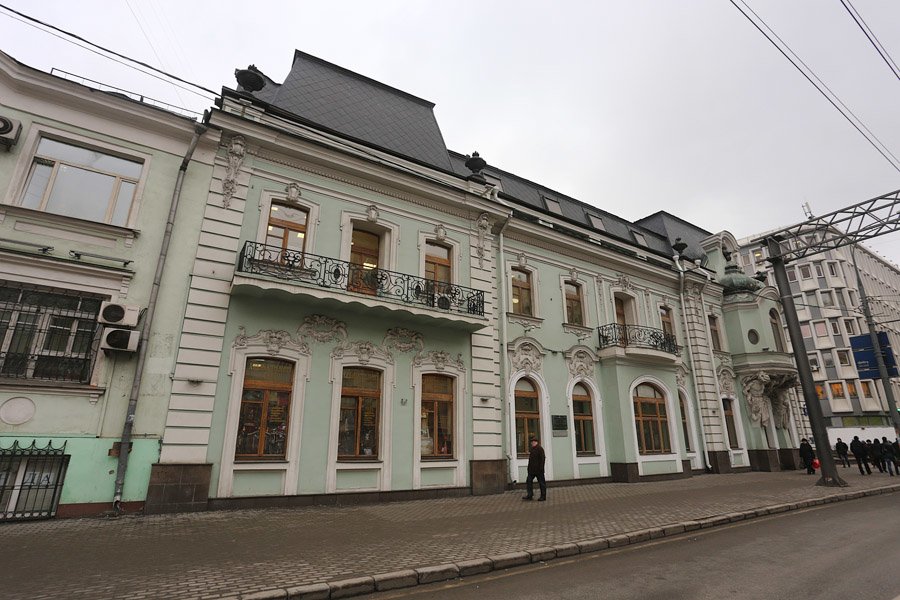Нынешний дом 41 по проспекту Мира (старое название — 1-я Мещанская улица) входил некогда в состав большой усадьбы, которая была построена еще в допожарные времена. В 90-х гг. XVIII в. тогдашний владелец усадьбы ротмистр Е.А. Зарин выстроил здесь главный двухэтажный дом и четыре симметрично стоящих флигеля — по два с каждой стороны от дома. Все строения были каменными.
Позже усадьбу купил подпоручик князь Никита Сергеевич Долгоруков; в 1812 г. усадьба пострадала от пожара, но была быстро восстановлена. Главный дом и флигеля приобрели облик, характерный для послепожарного ампира (главный дом сохранялся в таком виде вплоть до его сноса в 1970-х гг., сейчас приблизительно на его месте находится выход из метро «Проспект Мира»). Долгоруковы владели усадьбой до начала 1840-х гг., потом усадьба несколько раз переходила из рук в руки, пока наконец в 1875 г. ее не купил известный купец и промышленник, владелец фарфоровых заводов Матвей Сидорович Кузнецов (усадьба была приобретена на имя его жены Надежды Викуловны, урожденной Митюшиной). Поначалу никаких серьезных перестроек в усадьбе не проводилось, лишь были заново отделаны фасады жилых флигелей, во фронтонах которых появились изображения крылатых львов, держащих гербовый щит со стилизованными буквами К и М — по всей видимости, заглавные буквы фамилий «Кузнецовы» и «Митюшины».
В 1893 г. было решено перестроить южные (левые) флигели. В результате они были объединены в одно здание, которое представляло собой небольшой одно-двухэтажный особняк с эркером в средней части и достаточно скромным декором фасада. Автором проекта выступил известный архитектор Федор Осипович Шехтель. Позже Шехтель построил по заказу Кузнецовых еще один дом в этой же усадьбе — справа от главного дома, нынешний д. 43 - оригинальный особняк в неоготическом стиле (в советское время перестроенный почти до неузнаваемости).
На рубеже веков дом был еще раз перестроен, на этот раз авторами проекта выступили архитекторы Иван Сергеевич Кузнецов и Василий Григорьевич Иванов. Одноэтажная часть особняка была надстроена вторым этажом, а фасад получил совершенно новое декоративное оформление — в псевдобарочном стиле (с лепными наличниками окон, рустованными лопатками и оригинальным кровельным завершением). Особым украшением фасада являются изображения атлантов, держащих эркер второго этажа — их по заказу Кузнецовых создал молодой и мало кому тогда известный студент Московского училища живописи, ваяния и зодчества Сергей Тимофеевич Коненков, ставший в будущем выдающимся скульптором. Интерьеры особняка были богато отделаны лепниной, деревянными панелями, изразцами и мраморными каминами.
Сам Матвей Сидорович Кузнецов с женой жил в старом усадебном доме, а в этом особняке проживали его сыновья. После прихода к власти большевиков особняк, как и вся усадьба, был национализирован, в разное время здесь располагались различные административные учреждения. Большая часть подлинных интерьеров была уничтожена. Сейчас в одной части здания находится Московский общественный фонд культуры, в другой части — банк.
Dolgorukovs owned the estate until the beginning of 1840. Then homestead passed from hand to hand several times until finally in 1875 it was bought by almost an unknown merchant and industrialist, the owner of the porcelain factories Matthew Sydorovych Kuznetsov (the estate was purchased in the name of his wife, Nadezhda Vikulovna nee Mityushina). At first, no major rearrangements in the estate were conducted, but were refurbished facades of residential wings, gables in which there were images of winged lions holding a coat of arms with stylized letters K and M - apparently uppercase names " Kuznetsov " and " Mityushina." In 1893 it was decided to rebuild the southern (left ) wings. As a result, they were united in one building, which was a small one - story mansion with a bay window in the middle of quite modest decor and facade. The author of the project was the famous architect Fyodor Osipovich Shekhtel. Later Shekhtel built on order of Kuznetsovyh another house in the same manor - the right of the main house, the current, 43 - the original mansion in neo-Gothic style (in Soviet times remodeled almost beyond recognition ). At the turn of the century house was once again rebuilt, this time by the authors of the project are the architects Ivan Sergeyevich Kuznetsov and Vasily Ivanov. Single storey part of the mansion was layered second floor and got a brand new facade decoration - in barochnom style ( with molded architraves windows, rusticated blades and original roofing completion). Special decoration of the facade are images of Atlantis holding bay window of the second floor - they were created by the order of the Kuznetsov young and little known then student of the Moscow School of Painting, Sculpture and Architecture Sergey T. Konenkov, who in the future became outstanding sculptor. The interiors of the mansion were richly paneled moldings, wood paneling, tiles and marble fireplaces. Matthew Sydorovych Kuznetsov lived in an old manor house with his wife, and his sons lived in this house.
After the Bolsheviks came to power the house, as well as the whole estate was nationalized, at various times it housed various administrative agencies. Most of the original interior was destroyed. Now one part of the building is Moscow Public Foundation for Culture, on the other side houses the bank.











%20BEL_0521.jpg&w=1920&q=75)





